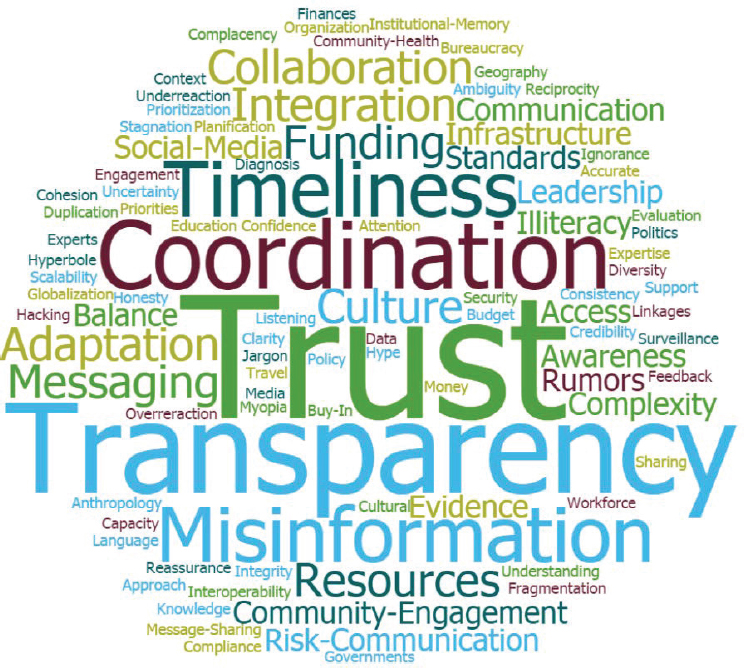7
Workshop Highlights and Reflections
Throughout the workshop, crosscutting themes emerged from the presentations and discussions on the challenges of strengthening communication capacity to prevent, detect, and respond to infectious disease threats and potential strategies and next steps in moving forward. Rafael Obregon, chief of the Communication for Development Section of the United Nations Children’s Fund, presented the results of polling practitioners, academics, researchers, and others from various sectors who work in areas of public health, communication, and emergency preparedness and response about the biggest challenge they face for building communication capacity to counter infectious disease threats. The workshop planning committee asked this question by email, Facebook, and Twitter more than 30 days prior to the workshop. The more than 150 responses were compiled into a word cloud (see Figure 7-1). Obregon observed that the key words that emerged from this poll are very similar to issues that arose throughout the workshop: trust, coordination, transparency, managing information, and integration. “In many ways, what this does is reinforces the criticality of these issues when it comes to building communication capacity,” said Obregon.
The workshop discussions over 1.5 days allowed participants not only to raise challenges, but also to review lessons and present potential strategies to strengthen communication capacities to counter infectious disease threats. Jeffrey Duchin, health officer and chief of the Communicable Disease Epidemiology and Immunization Section for Public Health in Seattle and King County, Washington, and Lonnie King, professor and dean emeritus of The Ohio State University College of Veterinary Medicine, sum-

SOURCE: Obregon presentation, December 14, 2016.
marized what they believed were the highlights of and the lessons learned from the discussions from day one and two of the workshop, respectively. For day one, when the discussions focused on the foundations of effective communication and achieving effective communication in practice, Duchin summarized his takeaways in the areas of leadership and policy; collaboration and trust; message design, delivery, and management; and research and evaluation (see Box 7-1).
Discussions on the second day focused on the role of data and evidence in informing communication strategies in the field, particularly drawing lessons from the recent Ebola and Zika outbreaks, and a systems perspective in strengthening risk communication for infectious disease threats. King
reflected that, when building communication capacity and designing messages, we need to remind ourselves that we begin with goals: “You begin with the end in mind, and the messaging is just not a message. It is how you achieve that end point—what is it we are trying to do, how that alters people’s behaviors, and is the message really true to that.” These messages, King added, should be supported by data as well as information derived from two-way communication between the communities and the experts. “In the midst of all the science,” King observed, “it is still about people, and empathy is a big part of that. If you are not sincere and really talk about the human issues that are involved in these terrible outbreaks, you lose credibility right away, no matter how smart you are.”
With all the complexity involved in managing outbreaks and communicating infectious disease threats, King stressed the need for interdisciplinary teams of clinicians, epidemiologists, social anthropologists, sociologists, information and technology experts, and others to work together. Redefining who is exactly responsible for risk communication during an outbreak may also be important. King said, “So often we think it is just a communication health expert, but we know now it is much more than that. People have to have skillsets in various parts of that outbreak to do that well.”
At the systems level, risk communication capacity is one of the core capacities that countries have to implement under the International Health Regulations. King emphasized the value of the joint external evaluation to assess the risk communication capacities of countries moving forward to ensure that countries have the ability to communicate promptly and adequately to prevent, detect, and respond to infectious disease threats. Standard operating procedures can be critical, providing tools and guiding actions and responsibilities when an outbreak occurs. As the emergence of infectious diseases and the cost of not doing more to respond to them is on the rise, King concluded his remarks by highlighting the importance of generating and applying science, reflecting on lessons learned, using that information to improve communication techniques and capacity, and coordinating with multiple partners to successfully counter infectious disease threats.




